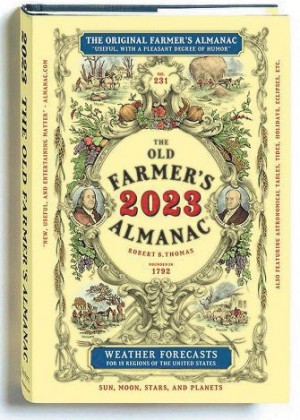Unique in content and inexplicably accurate, the “Old Farmer’s Almanac” stands as the oldest continuously published periodical in North America.
This little book (which is actually no more than a pamphlet) was first published by Robert B. Thomas in 1792 under the name “The Farmer’s Almanac.” Originally intended to be a regional publication, only 3,000 copies were printed. That number was increased to 9,000 in 1793 and circulation has grown ever since.
The success of the book is in large part attributable to Thomas’s uncanny ability to forecast the weather using a combination of astronomical cycles and weather patterns. Today, the Almanac employs state-of-the-art technology and the study of solar activity in their forecasting. While the forecasting methods used have been refined over the years, the basis for the predictions is still grounded in the original formula set down by Thomas over two centuries ago.
The outward appearance of the Almanac has changed very little in its lengthy history. There have been two notable alterations — in May of 1848 the word “Old” was permanently added to the title and in 1851 the “Four Seasons” drawing by Boston artist Hammatt Billing was added to the cover. Both changes are still used today.
Attempts have been made through time to alter the content of the Almanac. One of the most drastic changes came in 1920 when Robert Ware decided to modernize the pamphlet by turning the emphasis away from farming and give it a more metropolitan appeal. It didn’t take long for Ware to realize that the “Farmer’s Almanac” would never be accepted as the “Big City Almanac” and by the mid-20′s the original format was reinstated.
In 1936 editor Roger Scaife made the greatest blunder in Almanac history when he dropped the temperature and precipitation forecasts. The outcry from the public was so great that both returned the next year.
People take their Almanac quite seriously. Case in point: In 1858, then lawyer Abraham Lincoln used an almanac to argue the innocence of his client who was on trial for murder. A supposed eyewitness claimed he had seen the crime “by the light of the moon” on August 29, 1857. According to the almanac the moon on that date was not only in its first quarter, but at the time in question was riding “low” on the horizon, about to set. Case dismissed!
The amusing text and historic information contained in early Almanacs make them a popular collectible. The massive number of books in print make most of them fairly easy to find and modestly priced.
High-end examples include Almanacs printed before 1860 and the Kate Greenway Almanacs printed in England from 1883-1887. These are illustrated with twelve drawings of children, one for each month of the year and are collected as much for their art as for their text. Until next time . . . Linda
Linda Kennett is a retired professional liquidation consultant specializing in down-sizing for seniors and the liquidation of estates.



